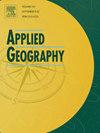基于移动监测和街景图像绘制城市路段行人暴露于空气污染的分布
IF 5.4
2区 地球科学
Q1 GEOGRAPHY
引用次数: 0
摘要
城市空气污染构成了重大的全球环境挑战,行人由于靠近道路交通且保护有限,特别容易受到影响。本研究调查了伦敦市中心行人暴露于PM2.5的空间分布,并利用空气污染移动监测数据和街景图像确定了高暴露路段。通过地理加权回归模型分析影响因素。结果表明:行人暴露具有空间聚集性,确定了两个高暴露热点;商业用地、交通运输设施、兴趣点(POIs)、建筑高度和街道宽高比与暴露水平呈正相关,而城市绿化率呈负相关。这些因素的影响因路段而异。基于这些结果和现有文献,本研究还提出了一个绿色基础设施规划框架,以减轻研究区域内行人暴露于空气污染的风险。本文章由计算机程序翻译,如有差异,请以英文原文为准。
Mapping the distribution of pedestrian exposure to air pollution on urban road segments based on mobile monitoring and street view images
Urban air pollution poses a significant global environmental challenge, with pedestrians being particularly vulnerable due to their proximity to road traffic and limited protection. This study investigated the spatial distribution of pedestrian exposure to PM2.5 in Central London and identified high-exposure road segments using air pollution mobile monitoring data and street view images. Influential factors were analyzed through a geographically weighted regression model. The results revealed that pedestrian exposure was spatially clustered, with two high-exposure hot spots identified. Commercial land use, traffic and transport facilities, points of interest (POIs), building height, and street aspect ratio were positively associated with exposure levels, while urban greenness exhibited a negative correlation. The effects of these factors varied across road segments. Based on these results and existing literature, the study also proposed a framework for green infrastructure planning to mitigate pedestrian exposure to air pollution in the study area.
求助全文
通过发布文献求助,成功后即可免费获取论文全文。
去求助
来源期刊

Applied Geography
GEOGRAPHY-
CiteScore
8.00
自引率
2.00%
发文量
134
期刊介绍:
Applied Geography is a journal devoted to the publication of research which utilizes geographic approaches (human, physical, nature-society and GIScience) to resolve human problems that have a spatial dimension. These problems may be related to the assessment, management and allocation of the world physical and/or human resources. The underlying rationale of the journal is that only through a clear understanding of the relevant societal, physical, and coupled natural-humans systems can we resolve such problems. Papers are invited on any theme involving the application of geographical theory and methodology in the resolution of human problems.
 求助内容:
求助内容: 应助结果提醒方式:
应助结果提醒方式:


